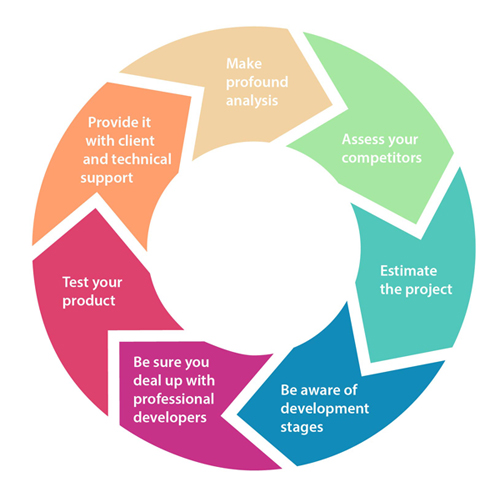There is always a stage in a company’s existence when the necessity of implementing an information technology system which supports all the processes (management, workflow, production) becomes inevitable. Managers in many companies come to the conclusion that developing their own software will be the most cost-effective and flexible solution which will meet all their specific demands and give them greater control. Besides that, own software provides the company with a competitive advantage reducing the time of executing the order and also enhancing the process itself.
But before you decide on developing your own software a profound analysis should be made. First of all you have to make a survey of the market to see whether your product is desirable here and if not to decide how you can make it work. After that try to assess your competitors. If there are no any, that is an alarm signal. This either means that your idea is not feasible and is not worth developing or your project can turn out to be something revolutionary which is seldom the case. Besides that you can take advantage of checking out your competitors. You will be able to learn what problems you might come across, what customers complain on and much more. Don’t forget to analyze your strengths and consider what will make you head and shoulders above your rivals.
Figure 1: Software development process
After making certain that your product can be profitable, you should take into consideration the estimated cost and the stages of the process. It would be very useful if you made a list with all the specified functionalities, requirements and scoping for the system. This is not to be just a simple outline. This list is to be a detailed description of all the components. This planning process can take quite a while: up to several weeks.
The next step that you have to take is to decide who will carry out the project. This person in charge is an intermediary between the project team and the customer. He transforms the primary conception into an ordered system first, and afterwards into a set of constituents that will be carried out by the team little by little. You should keep in mind that the designed person must be familiar with the specific IT jargon or else he wouldn’t be able to explain which client’s requirements the team must follow.
So as not to hinder free development of the software product in the future, some questions must be considered: can the company’s expectations evolve with the time, is the environment likely to alter, is it possible that marketing requirements will change over some period. Analyzing this information, it’s easier to predict whether the modifications or extensions will be needed further on. Then it’s time to choose a highly qualified expert being able to suggest a technology that enables those modifications. And the selection of technology shouldn’t be underestimated as mistakes here can bring additional expenses.
The next stage is building a team of programmers. You need to come up with the efficient way of candidate review and bar from the people who just pretend to be experts but in reality lack the required knowledge. Recruiting professionals from reliable software company instead of dealing with freelancers may secure the company against detrimental consequences.
As soon as the issue with the human resources is closed, you can set to the project delivery, which means the practical details of “code writing”. The terms of this stage depend on two factors: how complex the system you are working at is and how many members there are in your team. This period can last from a few to several months. In this phase consultations and fine-tuning are being made, and if any problems occur, the optimal solution is being designed.
After months of laborious work, when the software product is completely formed, it must be tested. Although it’s a time-consuming process and can even interfere with the habitual operations in the company, still you have to be rigorous and precise about everything in this stage. Don’t let any small inaccuracy be overlooked. Then the final go will be much more smoother.
The testing is usually run at two levels: programming and user levels. Beta testing is an external user acceptance testing. It’s really useful as it enables the users to get acquainted with your product and get feedback from them. The testing results in a list of all the components that need improvement is made. The team of programmers implement all the required alterations and remove bugs. That new version of the product also undergoes testing. This process continues until you finally get the satisfying product.
But it’s too early to breathe a sigh of relief: the work is not really over. You will still have to maintain the team who will take care of all the problems that might emerge in the future and who will improve the current product. The project is not a one-time effort, it’s an everlasting process. Client support services can significantly facilitate this job.
So as you see launching your own software is several times complicated than buying an out-of-the-box solution. It’s a very arduous, even intimidating at first sight process that requires capital investments as well as bringing a creative and devoted team into play and it also involves risks. There are no guarantees that the software you developed will be successful at the market. Still, it’s amazing experience and certainly worth doing. It’s up to you to decide whether you are ready for such a move or not.
Industries and Technology Areas
Industries: Information Technology
Technology Areas: software product development, custom software development










